Click-through rate (CTR) in B2B: Benchmarks & how to improve
Learn what click-through rate means in B2B marketing, see CTR benchmarks by channel, and get proven strategies to improve CTR across email, ads, and SEO.
Your B2B click-through rate (CTR) is a key metric, yet it’s often overlooked because clicks are challenging to earn.
The problem?
People often get hyper-focused on impressions—but clicks are what truly matter. Get a click, and you might just get a key conversion, such as a sale or inquiry.
In this article, we’ll cover everything there is to know about CTR in B2B digital marketing. You’ll learn what CTR is, how to track this critical marketing metric across campaigns, and its role in B2B marketing. After you’ve read this, you’ll know how to monitor CTR, talk confidently about CTR, and improve it.
What is click-through rate (CTR)?
Click-through rate is a metric that measures the percentage of people who clicked on a link compared to the number of people who saw it.
Click-through rate formula
The formula for CTR is simple. You need to know two things:
- How many people saw a link (impressions)?
- How many people clicked on the link (clicks)?
Then, you divide the number of clicks by the number of impressions. Multiplying by 100 gives you the percentage.
The formula looks like this:
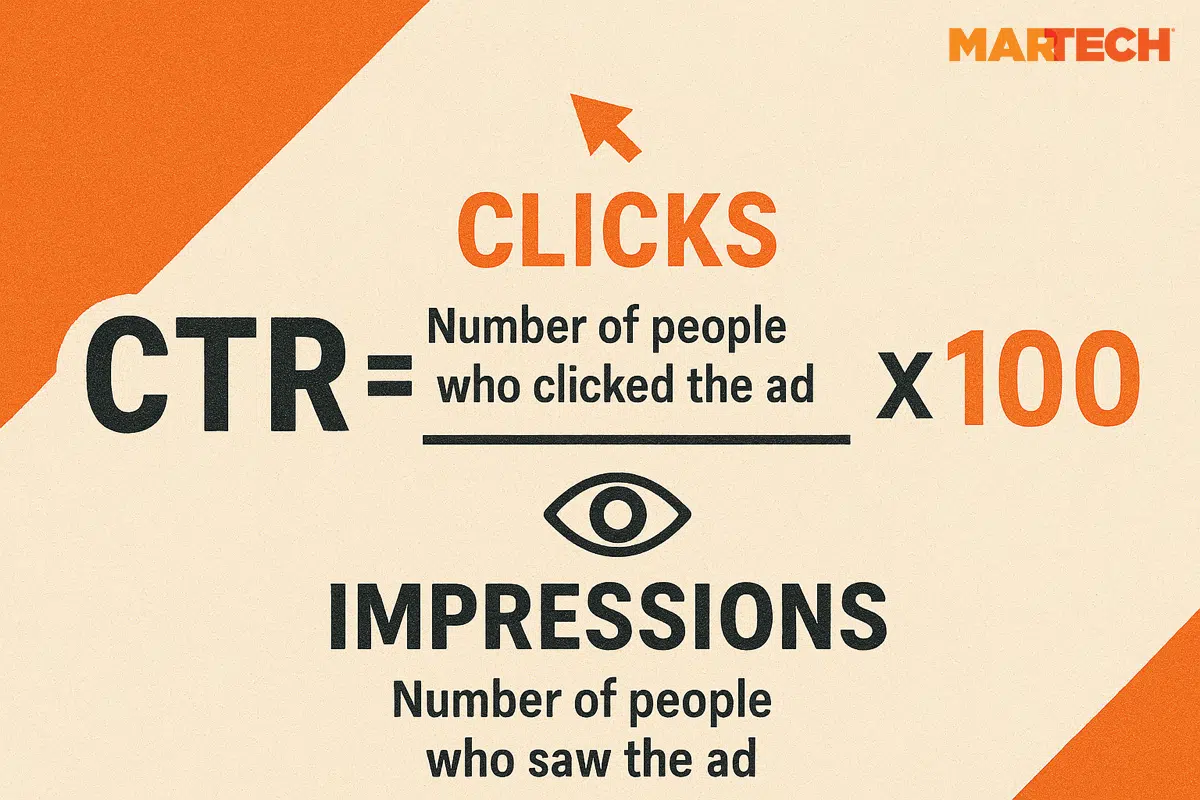
For example, if an ad has 1,000 impressions and 50 clicks, the formula looks like this:
(50 / 1,000) × 100 = 5%
How CTR is used in B2B marketing
In B2B, CTR is used across all marketing channels, including email marketing campaigns, paid ads, SEO, social media, and more.
- Email marketers use CTR to measure the number of recipients who clicked a link within an email after opening it. In this way, CTR helps assess how well messaging and calls to action are resonating with targeted recipients.
- Paid advertising across all channels uses CTR to determine the effectiveness of ad creatives, headlines, and targeting. Here, CTR informs optimization decisions by revealing which creative elements and audience segments are driving meaningful engagement.
- SEO relies on CTR to measure the percentage of users who click on your webpage from search engine results pages (SERPs) compared to the number of people who see it. CTR signals how effectively search listings compel action, offering insights into title relevance, meta descriptions, and content positioning.
Importantly, CTR should be measured across holistic B2B campaigns—more on this essential point in the next two sections.
SmileWorks Used Semrush to Benchmark Competitors and Grew 4,773%
✓ Compare your exact standing against local competitors
✓ Spot quick-fix visibility gaps in your market
✓ Find ranking opportunities competitors are missing
Free instant insights.
Why CTR matters for B2B & enterprise marketers
Let’s look at some of the reasons why CTR is so important in B2B marketing.
CTR signals content relevance and engagement
In B2B marketing, click-through rate (CTR) is a more reliable proxy for intent than passive metrics like impressions or email opens. While visibility metrics capture reach, they don’t reflect engagement. A user may scroll past an ad or delete an email without processing the message—actions that inflate impressions but offer little strategic value.
For example, in email marketing, someone might open an email but delete it without reading. These passive marketing touches rarely lead to conversions. Average click-through rate becomes more valuable than email open rate.
By contrast, when someone clicks a link, they’ve taken a positive and intentional action to engage with your brand.
A high CTR is an indicator that your:
- Messaging has resonated
- Targeting is correctly set up
- Ad creatives or imagery are working
- Marketing is compelling
Important note: If you work with freelancers or agencies, you want them to report on CTR and not just impressions. Visibility is useful, and it has its place, especially in longer B2B sales cycles—but clicks are what matter. Clicks indicate engagement and are actions that can lead to conversions or sales during a session.
CTR impacts quality score in PPC
In paid media, CTR is more than just a performance metric—it directly influences both ad placement and cost efficiency. On platforms like Google Ads, CTR plays a key role in determining Quality Score, which in turn affects your ad rank and cost-per-click.
A strong CTR signals to platforms that users are finding valuable, relevant content—aligning with Google’s prioritization of helpful, intent-driven experiences. For B2B marketers, this means higher placement, lower acquisition costs, and more efficient media spend when campaigns effectively engage the right decision-makers.
When it comes to Google Ads, a strong CTR may help you:
- Lower your cost-per-click
- Improve ad position so you appear higher
- Maximize ad budget efficiency
CTR helps optimize the sales funnel
B2B marketers operate within inherently complex sales environments—characterized by extended buying cycles and layered decision-making structures involving multiple stakeholders.
The solution is often to:
- Create campaigns that resonate with a range of stakeholders involved in the decision-making process
- Use omnichannel marketing that spans multiple channels and tactics
- Create engaging marketing campaigns that funnel users closer to conversion
For example, you might have an email addressed to engaged prospects. Within the email, you might share a webinar that is a middle-of-funnel marketing event meant to connect you with prospective buyers and provide details about your product or service. At this point in the buyer journey, your goal is to sign up leads for your webinar, with the aim of warming up the lead during the webinar and closing the sale shortly after.
It’s great to send the email and know that prospects are receiving it (metric: impressions) and opening it (metric: open rate).
You want to receive a reasonable, or better yet, high volume of clicks per impression to the landing page where you promote your webinar (metric: CTR).
CTR is a KPI for measuring campaign success
When you know what your CTR for a particular channel is, you can make further data-driven marketing decisions across campaigns.
Sticking with email as an example, you can:
- Assess email campaign effectiveness by A/B split testing subject lines and excerpts. The more people who click the link, the better the subject line performs.
- Assess audience segmentation. If the email has a high CTR, then the email list segmentation and offering was successful.
- Establish how large a segment needs to be in order to earn enough clicks and sign-ups.
All of the above are excellent for channel success, but you can achieve even more when you consider the entire B2B marketing funnel alongside CTR.
How CTR fits into the B2B marketing funnel
Your CTR data should be used in consideration with other metrics and the entire B2B marketing funnel.
Ultimately, CTR is the most important metric throughout any campaign, and it shows you how multi-channel marketing works as a whole.
We’re going to provide an example of how this works, but let’s first define multi-channel marketing, attribution, and why it’s important.
Multi-channel marketing
In B2B sales, multi-channel marketing is essential to navigating the extended and non-linear buyer’s journey. With multiple stakeholders involved—each with distinct priorities, pain points, and preferred channels—reaching and influencing the full decision-making unit requires tailored messaging delivered across the platforms they trust.
Ensuring consistent, relevant brand visibility throughout this journey is key to building consensus and accelerating consideration.
Your messaging needs to land with every buyer.
Consider a typical B2B purchase scenario: a marketing manager may seek a solution that streamlines workflows and enhances team productivity. They’re likely to engage with product reviews, industry publications, and peer recommendations—gravitating toward messaging that highlights practical features and ease of use.
Meanwhile, the finance director—also critical to the purchasing decision—is evaluating the investment through a different lens. Their focus is on cost-efficiency, ROI, and the tool’s ability to contribute to revenue growth or cost reduction.
A successful multi-channel strategy doesn’t just diversify touchpoints—it aligns differentiated messaging to the distinct needs of each stakeholder. This ensures that every influencer and decision-maker receives the information most relevant to their role, ultimately accelerating alignment and purchase readiness.
Multi-channel marketing and multi-touch attribution
Any campaign that spans multiple channels may encounter difficulties in attributing sales.
It’s common for last-touch attribution models to attribute the conversion solely to the final marketing channel. For example, a webinar converted 100 of 1,000 attendees into customers. Using the last-touch attribution model, the webinar resulted in a 10% conversion rate.
However, there’s a lot more to the story.
For the webinar to convert 10% of attendees, it relied on all the marketing efforts that occurred before it to bring the right audiences to the webinar.
Multi-touch attribution acknowledges each stage of the journey.
For example:
- A landing page that advertised the webinar had to be well-designed to encourage the penultimate CTR: a sign-up for the webinar.
- The email directing people to the landing page had to be well-written, well-designed, and targeted at a segment of people ready to join a webinar.
- The email segment needed to be made up of marketers in senior positions, so they could influence the decision to buy.
- Influencers, PR professionals, and social media marketers needed to promote the software in communities, industry journals, and across social media platforms. Email addresses were gathered in return for white papers.
It’s CTR that helps build this multi-touch attribution model.
Understanding the CTR by funnel stage, alongside other buyer journey metrics, like impressions, helps you understand what you need in terms of numbers to create a successful marketing campaign.
You can work backwards, establishing how many people a webinar can convert, how many people need to attend, and how many people need to see the email and click through to the webinar landing page.
Once you know the click-through rate of multiple marketing touchpoints, you can make data-driven marketing decisions across a campaign. Data provides marketing with an objective and holds marketing team members accountable to drive higher engagement.
The diagram below shows the journey a potential buyer might take.
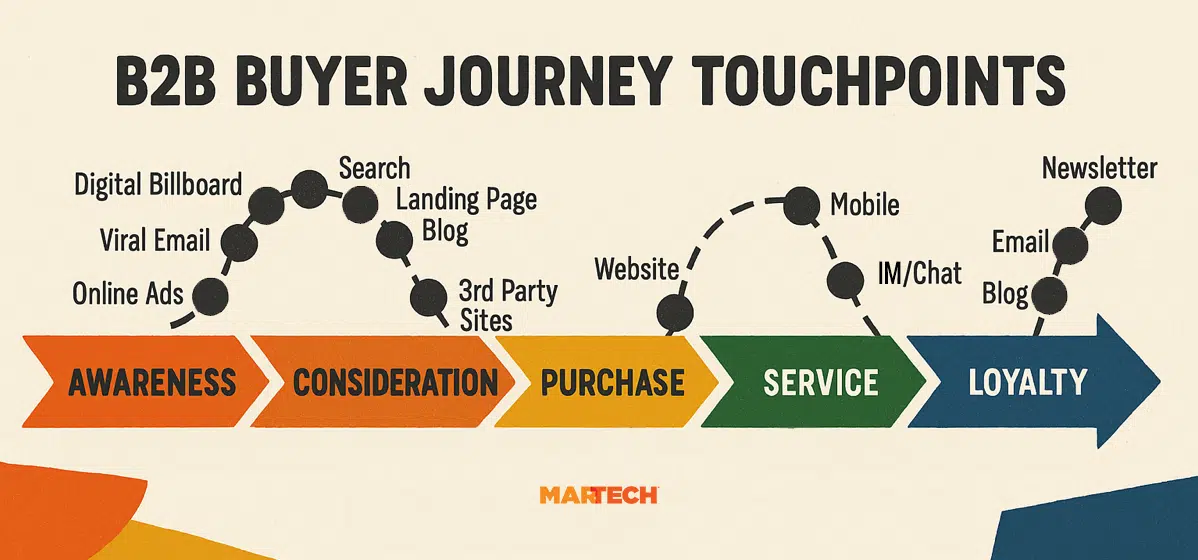
Important note: While higher click-through rates along the B2B marketing funnel are important, the end goal is what really matters. If CTR was high across the funnel but conversions at the end were low, then the marketing campaign could’ve been stronger.
When you look at a campaign holistically, you can fully understand the data, including what worked, what didn’t, and how you might improve your next campaign.
What is a good CTR? Benchmarks for B2B campaigns
A good CTR benchmark is influenced by many variables, including industry and channel. Ultimately, a good CTR is one that indicates strong sales. You can have a high CTR by channel, but end up with few sales. If this happens, the CTR, no matter how high, isn’t good at all.
The best way to manage CTR benchmarks is to analyze them after your campaigns end. Your campaigns provide a holistic view of the entire campaign. When examining the data and average CTR in B2B, you never get the full picture because you don’t know the final campaign performance. CTR benchmarks in isolation don’t tell the entire story.
That said, reviewing CTR benchmarks by channel and industry can provide guidance on what works and what you should aim for as you build your internal guidelines for your business and its audiences.
Here are the paid and organic CTRs in a range of B2B industries, according to First Page Sage’s 2025 CTR benchmarks.
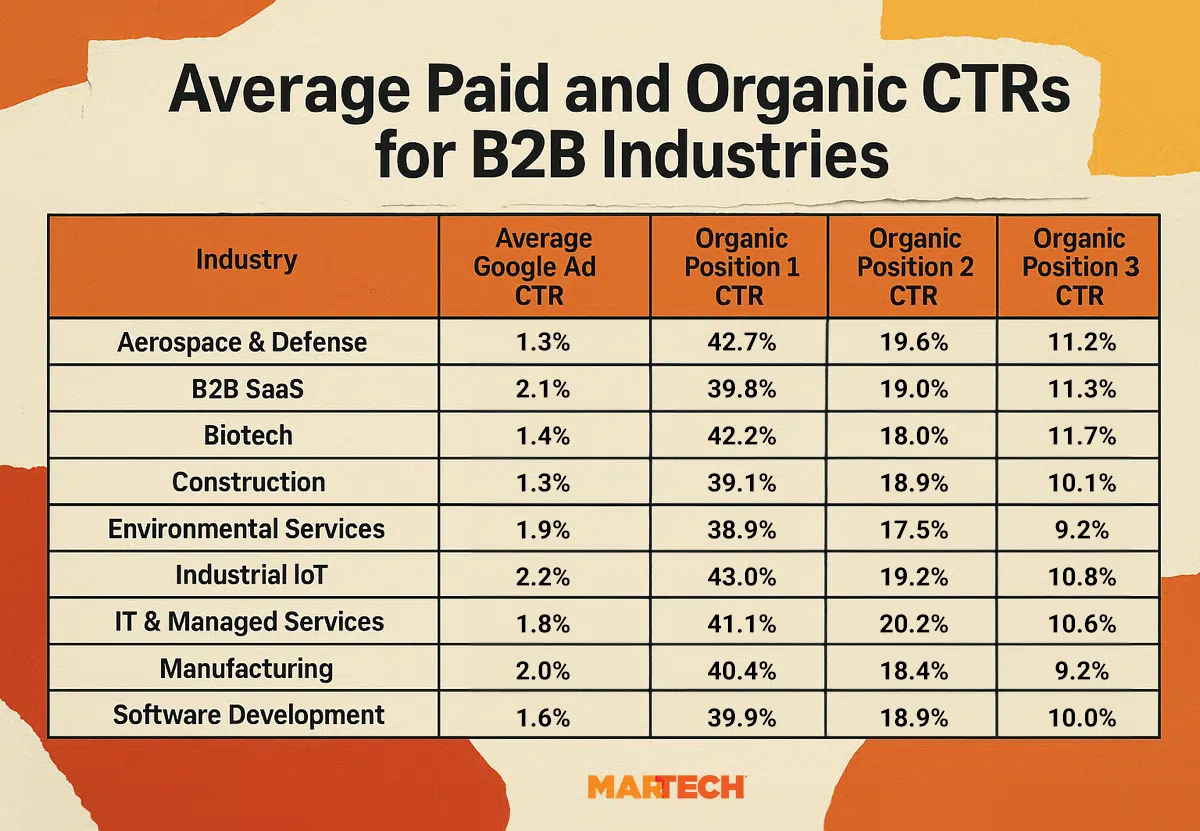
The role of messaging, creative, and copywriting
Creative messaging and copywriting are nearly always key factors in improving B2B click-through rates. Remember: Boosting CTR is about encouraging and earning the click.
There are several ways that CTR copywriting can encourage a click.
Compelling headlines
An effective headline immediately signals relevance, reassuring your audience that your solution aligns with their needs and that they’re in the right place to explore it further.
Compelling headlines designed for CTR optimization might include:
- Questions that connect directly to your audience’s needs
- How-to headlines that present a solution to your audience’s problem
- Problem-and-solution headlines that connect your audience’s problem directly to the solution

CTR copywriting best practices
There are copywriting formulas that can help boost CTR. A proven copywriting formula is the “Problem, Agitate, Solution” (PAS) approach. This CTR copywriting formula is designed to:
- Outline the problem your user has early on, probably within the first sentence
- Agitate the reader by reminding them why their problem matters
- Present your offer as the clear solution
The PAS formula can be used in a headline or paragraph, or across an entire landing page.
A formula like this, combined with a well-designed call-to-action (CTA), may boost your B2B click-through rate (CTR).
Design
While you improve CTR with messaging, design plays a crucial role. How the content looks and feels is essential. You might design calls to action, such as banners within landing pages or stylized buttons, that encourage a user’s click.
How to improve CTR in B2B campaigns
While excellent copywriting will lead to increased CTR across all channels, there are some channel-specific tips that will help you increase CTR. Let’s break down how you can improve CTR across marketing channels.
Email campaigns
Email CTR is increased through engaging subject lines and excerpts that can appear in the mailbox before a recipient has opened it.
You can increase email click-through rate with the following tips:
- Personalized subject lines increase CTR because the recipient can see the email was intended for them and may not be a send-to-all email.
- A/B split testing has a crucial role in B2B email optimization. You can send a variation of an email to a percentage of your recipients. Perhaps you try two subject lines, for example. The subject line with the highest CTR is the winner and is sent to the remaining recipients.
- Enhance email templates to strike the right balance between clarity and design—delivering a seamless user experience while driving decisive action.
- Strong CTA alignment is achieved with audience segmentation. If you know what your audience is looking for, you can serve them better. You might segment an audience by people who have clicked a certain page but not converted, or who have viewed items in a basket but haven’t made the sale yet. These are high-intent segments with a specific interest or need that you can address.
Paid media (search, display, social)
Ad CTR is directly influenced by the strength of your creative—both the clarity and relevance of your B2B messaging and the impact of supporting visuals or media.
One key advantage of paid media in the B2B space is its measurability. Campaigns can be continuously optimized through real-time testing of copy, creative assets, and audience segments, allowing teams to refine performance with precision and speed.
- Ad copy and images should be highly engaging and designed to stop the scroll.
- A/B split test copy and media to see what earns the most clicks and the highest CTR.
- Audience targeting is easily altered on platforms, and precision is crucial. Platforms like LinkedIn offer very granular targeting, allowing you to refine by location, company size, job title, seniority, skills, and more. Adjusting your audience can dramatically improve CTR by ensuring your ads reach the most relevant users.
- Messaging alignment ensures your ad speaks directly to the audience’s needs or pain points. Messaging that feels highly relevant to the target audience will naturally drive a higher CTR.
Account-based marketing (ABM)
Account-based marketing (ABM) is rooted in precision and personalization. When you deeply understand your target accounts—their priorities, pain points, and buying context—you can deliver messaging that speaks directly to what matters most before the first click.
CTR in ABM campaigns tends to improve when outreach is tailored by firmographics such as company size, industry, role, and location. This level of customization aligns with the broader principles outlined above: relevance drives engagement, and specificity earns attention in competitive B2B landscapes.
You might:
- Offer playbooks specific to audience needs: Account-based marketing requires a deep understanding of your prospect. If you can solve your audience’s problems or make their jobs easier, then you might earn a click and an email exchange for a valuable playbook or whitepaper that supports your audience’s marketing goals.
- Create dynamic ad campaigns and retargeting strategies: Utilize creatives and content that target specific account data.
Improving click-through in ABM campaigns is about intimately knowing your audience, their problems, and the solutions they most need. You will likely need to work closely with sales or customer service to build a picture of your audience.
SEO & organic content
When we think about organic CTR, the first thought is usually regarding title tag and meta description optimization, which is undoubtedly a great place to start. But, there’s more.
Title tag and meta description optimization:
Compelling content earns clicks. When you’re ranking in the Google search results, the competition is high. At minimum, your organic listing is competing with at least nine other websites (usually) that also want the click. There are also ads and other SERP features such as maps, featured snippets, people also ask, AI overviews, and more.
Title tags and meta descriptions should encourage people to choose your listing over all other competitors.
It’s not uncommon for title tag or meta description CTR optimization to be overlooked as a tactic for improving CTR, as Google often rewrites or truncates title tags and—especially—meta descriptions.
However, it will never hurt your CTR to write your title tags and meta descriptions with the intention of earning the click. There will be plenty of opportunities where title tags and meta descriptions are displayed exactly as you wrote them. Plus, Google seeks to display the most helpful content. If your title tag and meta description match user intent, there’s a good chance they will display.
Further reading: How to write title tags and meta descriptions for more clicks.
While your title tag and meta description should be compelling, you also want to incorporate your SEO best practices, such as including relevant keywords.
If you’re using a tool like Semrush, then you can rely on the Site Audit tool to highlight title tag issues, including:
- Missing title tags
- Title tags that are too long
- Duplicate title tags
You can use this data to audit your title tags and rewrite them.
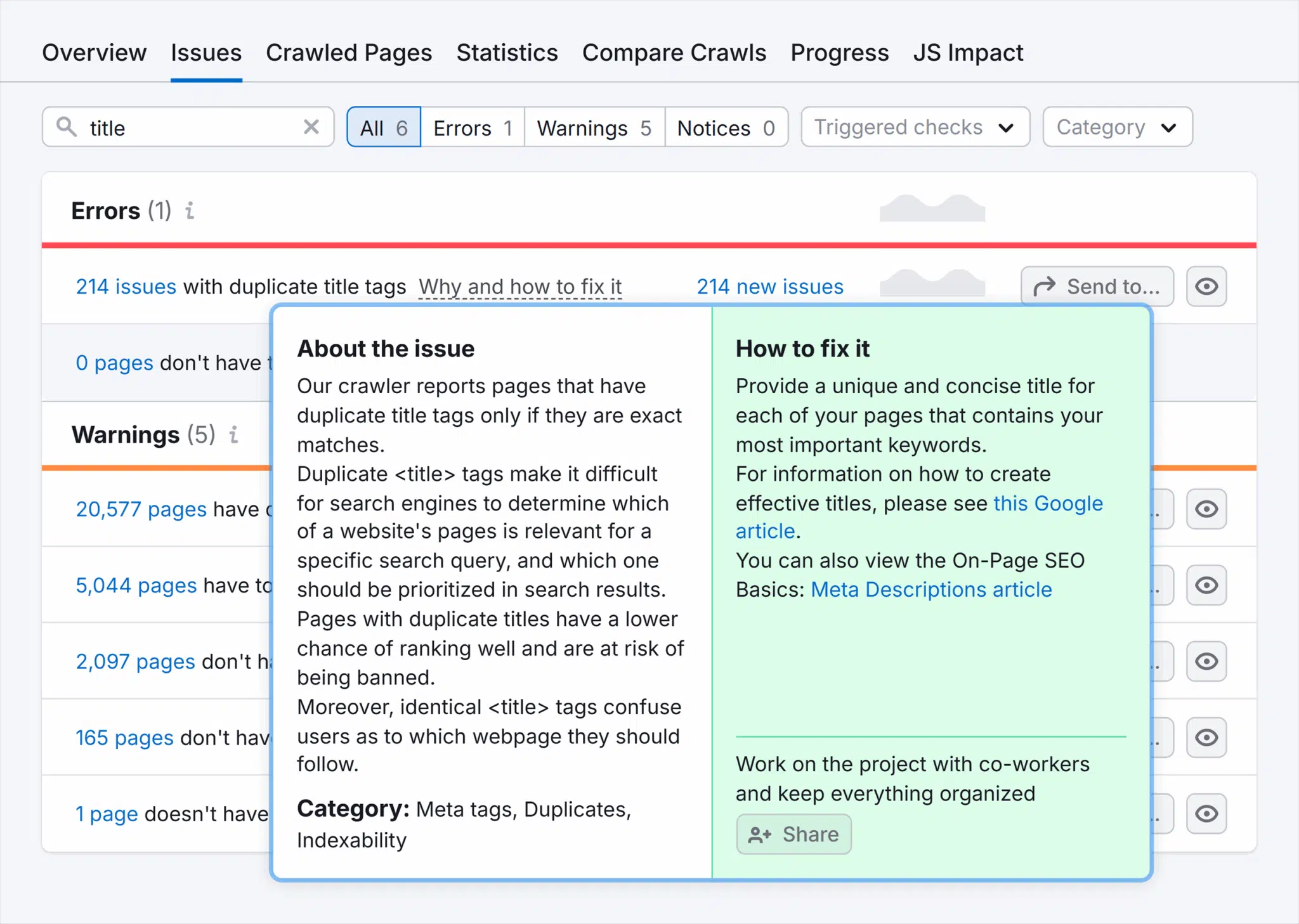
Optimize for the featured snippet or AI overview:
If you can rank a page within the featured snippet, there is a high chance you’ll significantly boost organic click-through rate.
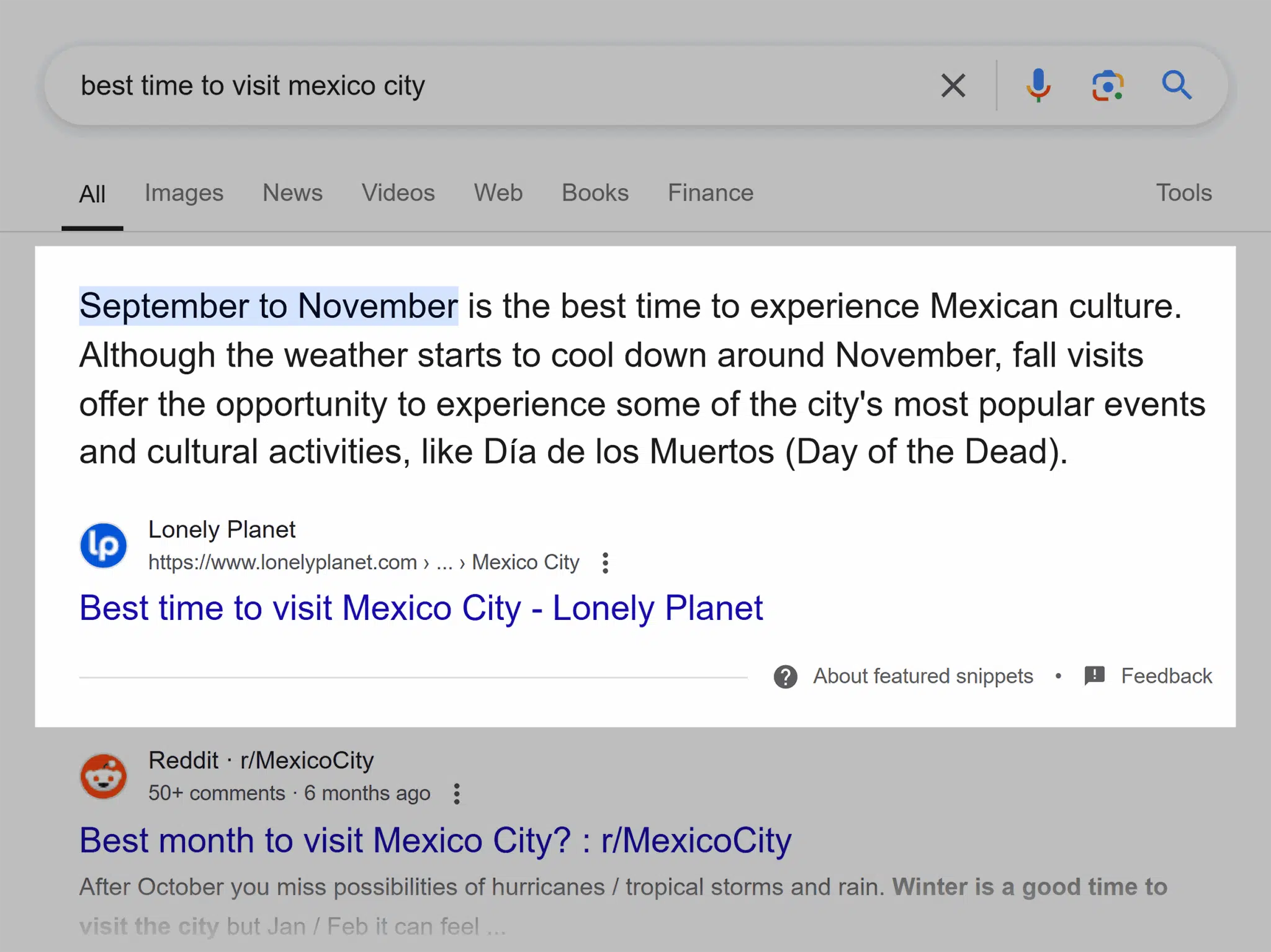
The featured snippet is highly engaging because:
- It takes up a lot of space.
- It’s displayed at the very top of the organic results.
- Often, the featured snippet is accompanied by relevant images.
- The extended snippet displays more content, showing the searcher that your page is exactly what they were looking for.
Further reading: How to steal your competitors’ featured snippets with ChatGPT (prompts included) and How to get Google featured snippets: 9 optimization guidelines.
Enhance SERP appearance with schema:
Schema is code that you can add to your site. While not visible to users, it delivers data to Google, adds context to pages, and provides entities that may be displayed in Google search results.
A good example is review stars displayed in the SERPs.
Here’s an image showing you what that looks like for a B2B listing. As you can see in the screenshot, the B2B service has an associated 40 reviews and a 5.0 rating. Compared to competitors with no star ratings, this is very compelling.
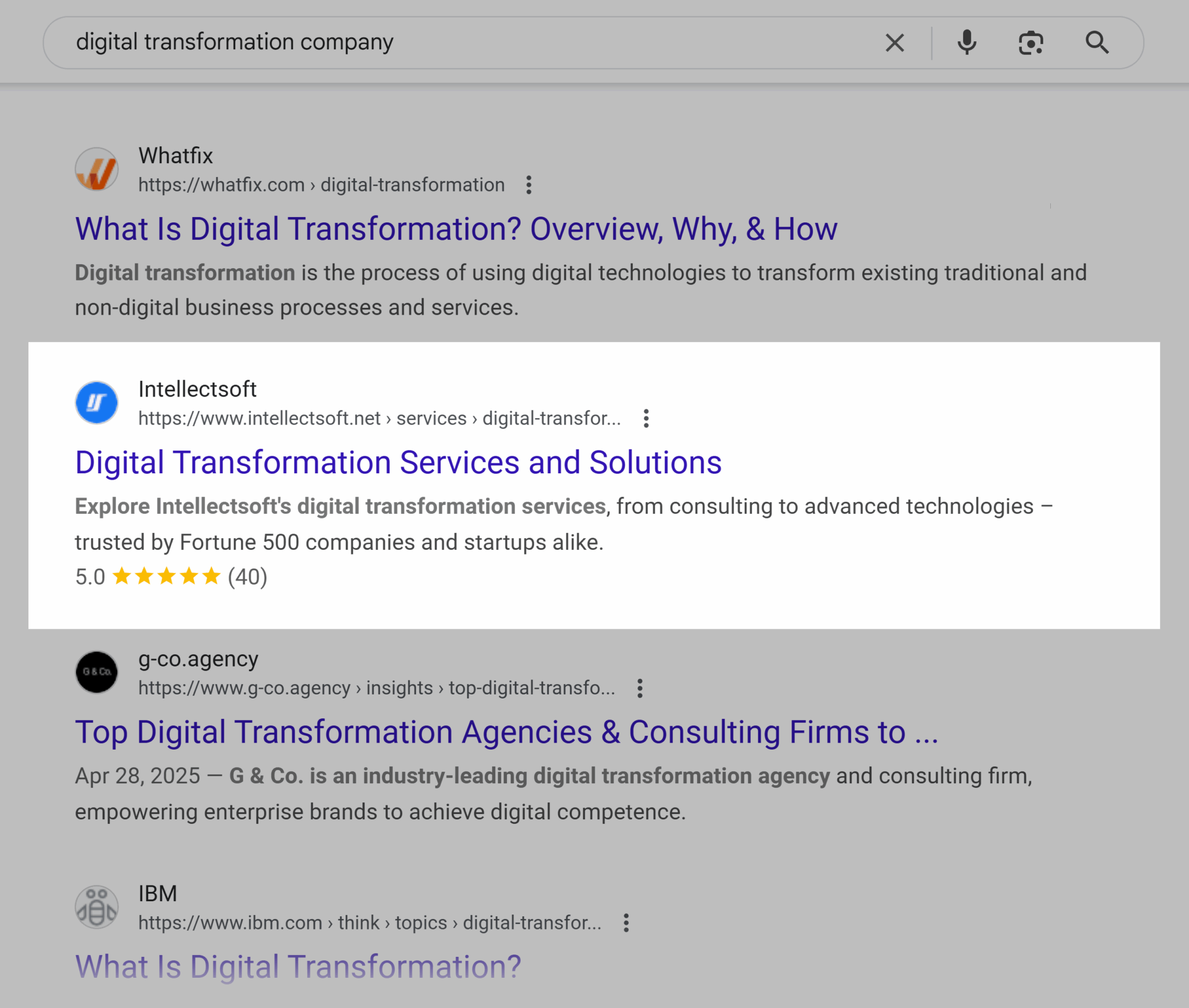
The review stars are achieved using the aggregateRating schema.
Some common SERP enhancements that you can add with schema include:
- Reviewed by can feature your reviews, the rating, and the name of the person who left it.
- Star ratings appear in SERPs and aggregate overall ratings for your service (see screenshot above).
- Events are sometimes listed at the top of the SERPs.
- Pricing can help your price appear in the SERPs.
Further reading: Structured data and SEO: What you need to know in 2025
There are many opportunities to add structured data to pages. The best thing you can do is review schema.org to see what you can include in your page.
Be careful with schema. You might need developer input. Many schema properties are added automatically by your content management system (CMS) and website plugins. Yoast includes a lot, for example. You don’t want to add schema twice or in the wrong places.
Pro tip: You can check if your schema is correct using Schema Validator, or you can rely on Semrush’s Site Audit, which flags schema errors.
Here’s a look at how you can review schema on your website using Semrush.
Navigate to “Site Audit” and scroll to “Thematic Reports.”
Under “Markup,” click on “View Details” to see the report below:

The report details the types of schema this B2B site is using and identifies where they are valid or invalid.
The goal is to have a score of 100% and no invalid items.
UX tracking and CTR metrics on the page:
Once a user clicks through from Google to your site, CTR becomes a valuable lens for evaluating how well the landing page aligns with search intent and drives action.
Each page should be designed with a clear objective—one that reflects the visitor’s likely stage in the buyer’s journey. SEO provides critical context here: by mapping keywords to intent, you can infer where the user is in the funnel and tailor the on-page experience accordingly. When search intent is well understood, you’re positioned to deliver precisely what the visitor is seeking—driving stronger engagement and higher conversion potential.
Once a visitor lands on your page, your calls to action (CTAs) should be both visually compelling and strategically aligned—guiding users toward the next logical step in their journey, whether that’s booking a demo, initiating a purchase, or engaging with gated content.
Effective on-page CTRs serve as a critical feedback loop, helping you evaluate whether your SEO efforts and page experience are successfully advancing business and marketing objectives. Whether you’re capturing demand or nurturing early interest, these metrics reveal how well your content is converting attention into meaningful action.
Common pitfalls and misconceptions of B2B CTR
Before we finish this article, let’s address common pitfalls and misconceptions of CTR when working in B2B industries, so you know what to avoid.
Marketing channels working in silos
It’s common, and detrimental, that marketing channels work in silos. This means that well-intentioned marketing teams are working toward a goal without considering what’s happening across the campaign.
A good example might be “get more leads for sales,” which isn’t very helpful and doesn’t consider the buyer journey.
While this is a good goal, sophisticated marketing goals consider the journeys of all decision-makers and how each channel can influence the buyer’s journey, from awareness through to conversion. Cross-functional collaboration at every stage, from reviewing benchmark reports to auditing creative, can help maximize ROI.
Isolating CTR to channel success
If channels are working in silos, then your CTR is more likely to be isolated to channel success. We touched on this throughout the article, but CTR by channel isn’t the most helpful way to benchmark and gauge CTR success in B2B.
It’s critical that CTR is considered holistically, with sales in mind, so you can properly attribute the value of the clicks.
Using only last-touch attribution
Similarly, it’s a common CTR mistake to consider only the last click. Last-touch attribution attributes only the final click to the conversion. It’s better to review the campaign as a whole and assign values to clicks further up the funnel.
Pro tip: In GA4 you can assign a monetary value to a key event, such as a whitepaper download to qualify the role of earlier marketing touchpoints.
Over-attributing channels or duplicate attributions
Following on from an overreliance on using the last-touch attribution, some B2B CTR is misinterpreted because of over-attribution or duplicate attributions.
E-marketing tools like Klaviyo and Google Ads have their own attribution windows. It’s possible that someone might’ve clicked to your website from both an email and an ad. In this case, the same person has added clicks to your metrics on two different campaigns.
If that person converts at the end, then email and ads will both be credited with the click.
Expecting B2C benchmarks in a B2B industry
Unlike B2B, B2C industries experience faster sales cycles. You must not compare B2B metrics to B2C.
Analyze and improve your B2B click-through rate
B2B click-through rate is a nuanced metric shaped by multiple variables across channels and stages of the buyer journey. It’s not something perfected in a single campaign—optimizing CTR is an ongoing, iterative process that takes time, data, and strategic refinement.
Sophisticated B2B marketers continuously analyze performance across individual channels while also assessing how each touchpoint contributes to broader campaign objectives. The goal isn’t just higher CTRs in isolation, but smarter, more connected marketing that moves buyers forward with purpose.
If you’re ready to improve your click-through rate, get started on mapping your buyer journey. The data found within the Traffic Analytics report is particularly insightful for this task.
As you optimize for CTR, it’s essential to move beyond surface-level metrics. Conduct regular audits to understand which campaigns and channels not only drive clicks—but drive the right clicks. Identify which engagements ultimately lead to pipeline progression or closed deals, and assess whether your highest-CTR sources are attracting qualified, conversion-ready traffic.